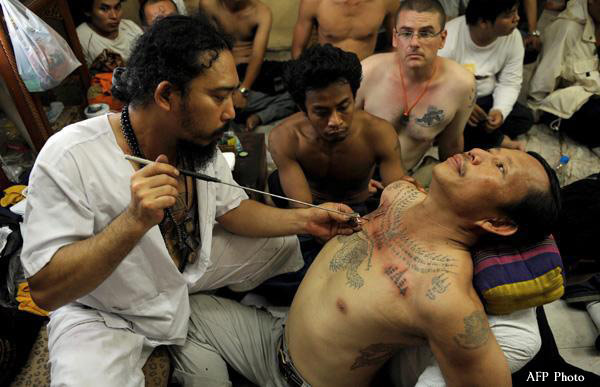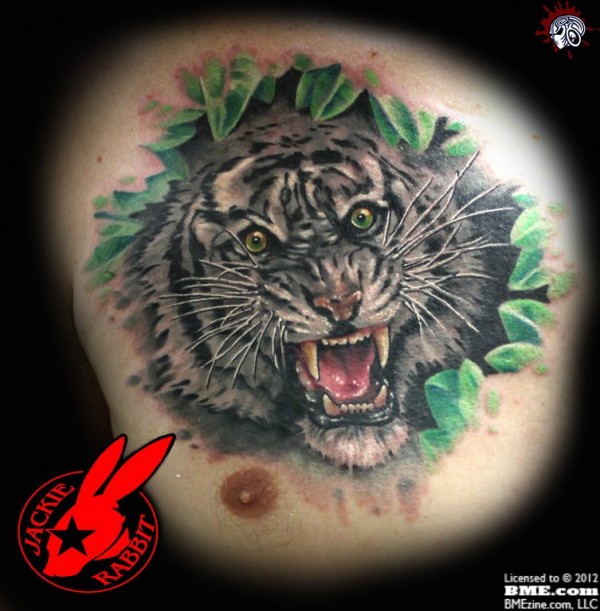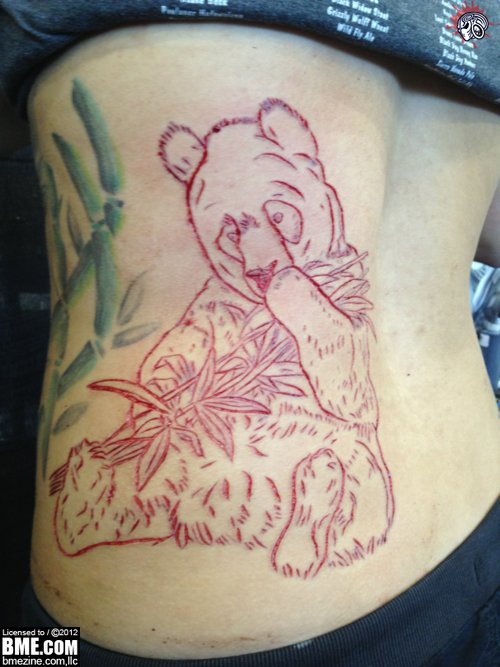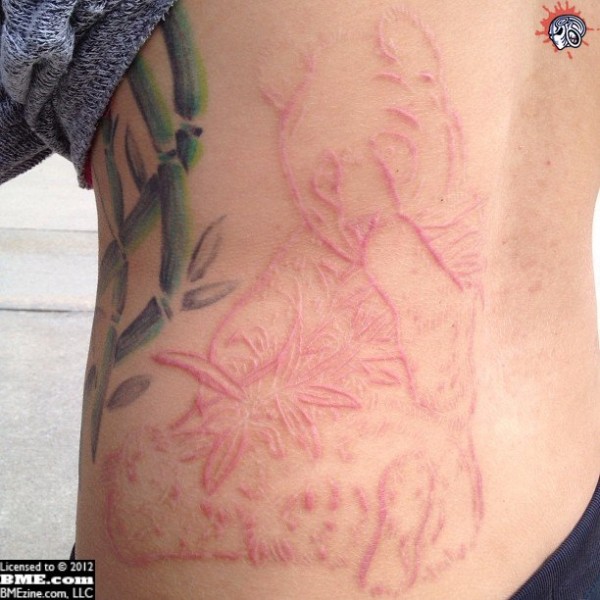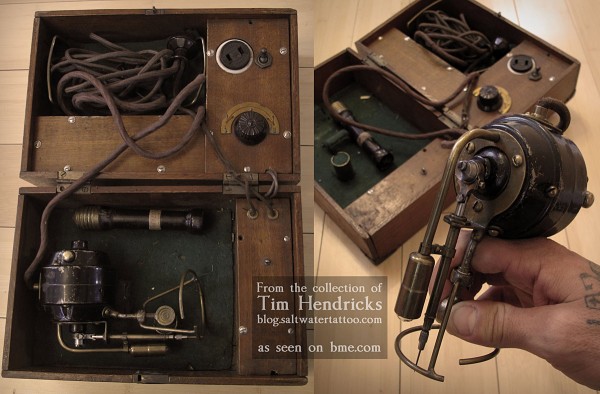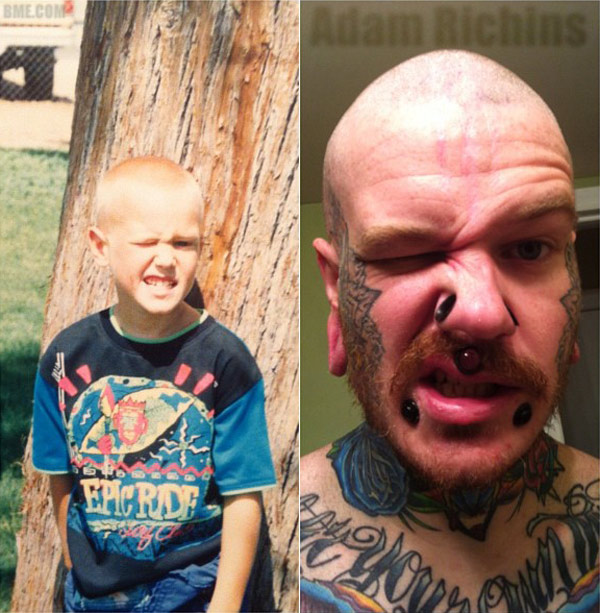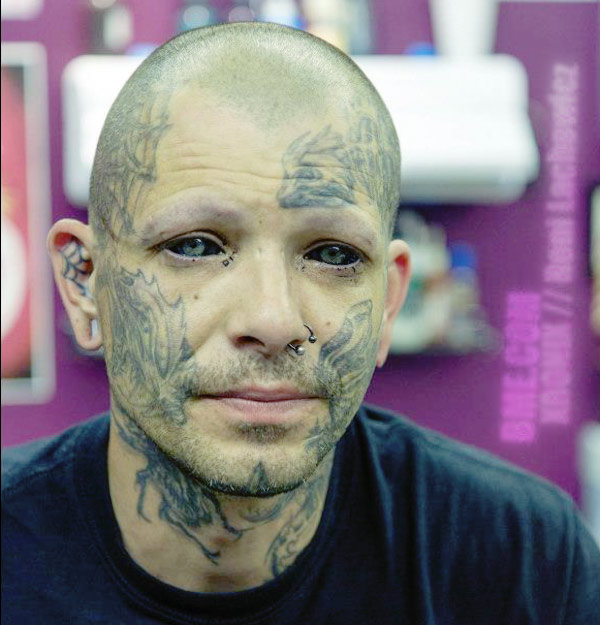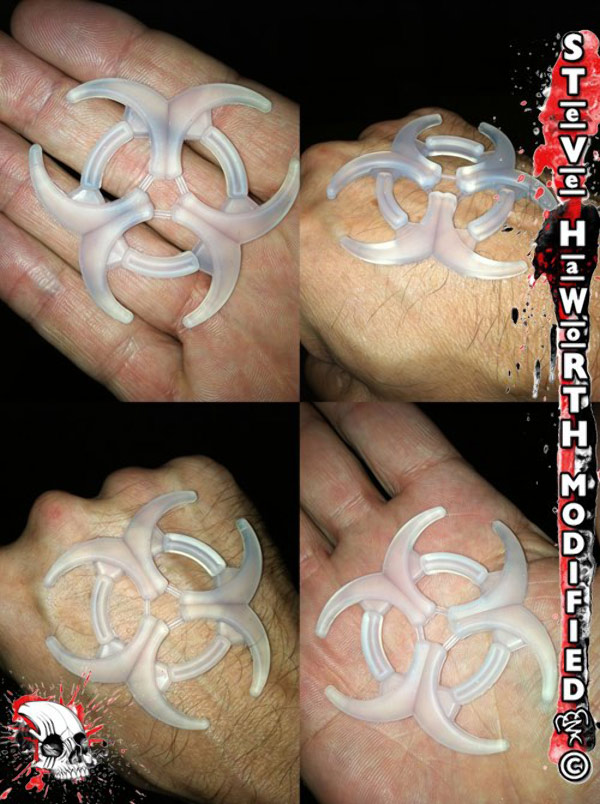It’s been a very long time since I’ve done a historial “tattoos in the news” column, and I think perhaps it’s time to revive that. Today I shall cover a cross-section of mentions of tattoos and body modification in the news in the year 1890. In 1890 tattoos were already quite common and well known, and even a “trend” in some areas, among both the upper classes and among sailors, as well as there being wide awareness of body modification in tribal cultures. But I want to begin with my absolute favorite article of the year, which I read in the Acton Concord Enterprise of March 28, 1890 — although I should mention they were quoting The Philadelphia Inquirer and that this story was widely printed across North America. In short, a deaf-and-dumb girl is tattooed with the alphabet on her forearm, and learns to communicate by “typing” out words — and having responses typed back. Keep in mind that this was before ASL was standard, so there were many creative methods of dealing with deafmute communication — this is definitely one of the more interesting!
TALKS WITH HER ARM
Where a Deaf and Dumb Girl Carries the Alphabet and How She Uses It
“James V. Dorpman and daughter, Lodge Pole, Nebraska,” is written in a bold hand on the register at the Ridgway house. Mr. Dorpman is a tall, well built man of 60 years, with a long beard strongly tinged with gray. His daughter is about 18 years old. She has an intelligent, pretty face and the brightest and bluest kind of bright blue eyes.
When Mr. Dorpman and his daughter first came to the Ridgway house they attracted the attention and curiosity of the guests by their strange behavior. Whether in the parlor or in the dining room, Mr. Dorpman always sat on the left hand side of his daughter and tapped her left arm constantly with two fingers of his right hand, as though playing on a typewriter. His fingers skipped nimbly at random from the girl’s wrist almost to her shoulder and back again. At intervals he paused and the girl smiled, nodded her head or else tapped her left arm in the same manner with the fingers of her right arm, the old man closely watching their movements.
The strange actions of the couple were subjects of continual comment and speculation among tho guests. Finally Borne one noticed that the father and daughter were never heard to exchange a word. They always sat quietly when in each other’s presence, and were always drumming on tho girl’s arm as if it were a pianoforte. The girl kept away from the other guests of her sex, and was never seen in conversation with any one. At the dining table Mr. Dorpman gave the orders to the waiters both for himself and his daughter. When Proprietor Butterworth met the young woman on the stairs and said affably, “Good morning,” she never answered.
The strange actions of the couple occasioned such widespread comment and curiosity among the guests that finally Proprietor Butterworth approached Mr. Dorpman while he was standing at the cigar counter one day, and after a few minutes of general conversation asked him to explain the cause of his constant tapping on his daughter’s arm.
“So you’ve noticed that, eh?” said Mr. Dorpman with a laugh. “Well, that is how I talk to Hattie. Sho is deaf and dumb.”
Mr. Butterworth asked him how he was able to converse with bis daughter by simply drumming on her arm.
“You’ll think it is easy after I tell you,” he answered. “You must remember that we came from an obscure part of Nebraska, settled there with my wife a quarter of a century ago. Eighteen years ago, when Hattie was born, there was not a house within a mile of us, nor a city within sixty miles. As the child grew older we discovered that she was deaf and dumb. We were at a loss how to communicate with her. We were far away from a civilized community, and no one that we knew was familiar with the sign manual for deaf mutes, so that the baby grew to be a child before we could devise a scheme to talk to her.
“Finally my wife hit upon a novel idea. She got a clever young fellow who worked for us to tattoo the alphabet on Hattie’s arm. The letter ‘A’ began just above the wrist, and the letter ‘Z’ ended just below tho shoulder blade. Hattie was then 5 years old. In less than a year by this means my wife and I had taught her the alphabet.
“Then we began to spell out words by touching each letter very slowly with our fingers. As the child learned we became faster, and when Hattie was 12 years old we were able to talk to her as rapidly as a person can spell out words on a typewriter. Hattie, too, learned to answer us by drumming on her tattooed arm. Of course, for several years at first, when we wanted to talk to her, or she to us, she had to roll up the sleeve of her left arm. Gradually her sense of touch became so fine that she knew without looking just where each letter was located, and her mother and I, by constant practice, were enabled to strike these letters with her sleeves rolled down.
“The tattoo was not very deep, and by tho time Hattie was 16 years of age it had entirely disappeared, leaving her arm as white and spotless as a woman’s arm could be. But she knows just where each letter was, and so do I, for I have been drumming on her arm ever since she was knee high to a grasshopper. Of course, I am the only person alive able to talk with her, as my wife died about six months ago, but I hope to arrange so that she may be able to talk to others. While we are on east I am going to get some one to instruct her in the sign manual. She is bright and quick and will soon learn.”
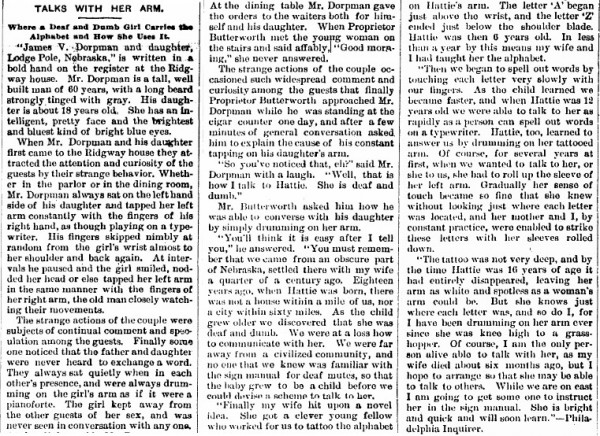
More stories continue after the break.
I found a great many news pieces describing cultures around the world, ranging from quite xenophobic to almost adoring. I’ll start at the less friendly end of the scale. This is from the Spirit Lake Beacon, March 21st, 1890 — of course, it is about cannibals, which really starts most people off on the wrong foot.
DEGRADED SAVAGES
Things Told by Dr. Carl Lumholtz About Queensland Cannibals.
They tattoo their children in the crudest way, cutting parallel lines across the breast and stomach with sharp stones and clam-shells, and keeping the wounds from healing by filling them up with ashes or charcoal. The shoulders are cut in the same manner until they look like epaulets.
…and later on…
They frequently flog their wives brutally, and if she runs away to some one more kind, the husband is privileged to maim her when he sees her. This is what they call “marking” a woman.
A more neutral article about another cannibal group in the Congo also mentions tattoos, in this November 12th article in the Sterlin Illinois Evening Gazette.
Wonders of the Great Forests
There are many inhabitants in the region, but they could be classed into the tall inhabitants and the pygmies. The tall natives occupy the clearings; the pygmies are found in groups in the forests. The different tribes of each are distinguished by marks, some having tattoo marks on their foreheads, and others on their cheeks.
This mention of tattooing in Algeria, which I found repeated in dozens of papers, syndicated in their trivia columns was more neutral. This particular example is one of the earlier mentions, from the Salt Lake City Tribune on January 5th, 1890.
In Algeria every girl born of native parents is tattooed on her forehead between the eyebrows and just at the root of the nose with a cross formed of several straight lines of small stars running close together. Those tattoo marks are a a dark blue color. Algerian women ara also considerably tattooed on the backs of their hands, their forearms and chests, as well as on their shoulders, their wrists being especially adorned with drawings representing bracelets and flowers strung together As a rule, women are the operators, and it is principally on children between the ages of seven and eight that they have to exercise their art. They use sometimes a needle, but more frequently a Barbary fig-tree thorn. They employ kohl as a coloring substance. It is a kind of fine powder made from sulphur of antimony, which is also in great request by the Algerian women for the purpose of face-painting.
I found an interesting and positive story about tattooing in Polynesia in the Oelwein Register called “Tattooing the Body”
Tattooing is by no means confined to the Polynesians, but the “dermal art” is certainly carried by them to an extent which is unequaled by any other people. It pervades all the principal groups of islands, and is practiced by all classes, though to a greater extent by the Marquesans and New Zealanders than any others. By the vast number of them it is adopted simply as a personal ornament, though there are some grounds for believing that the tattoo may, in a few cases and to a small extent, be looked upon as a badge of mourning or a memento of a departed friend. Like everything else in Polynesia, its origin is related in a legend, which credits its invention to the gods and says it was first practised by the children of Taatoa, their principal deity.
The sons of Taaroa and Apouvaru were the gods of tattooing, and their images were kept in the temples of those who practiced the art as a profession, and to them petitions are offered that the figures might be handsome, attract attention and otherwise accomplish the ends for which they submitted themselves to this painful operation. The coloring matter was the charcoal of the candlennut mixed with oil, and the instrument used was a needle made of fishbone, and a thread was drawn through the skin, after which puncturing the black coloring matter was injected with instruments made for the purpose. To show any signs of suffering under the operation is looked upon as disgraceful, and accordingly, in some of the islands, while the operation is going on the young man undergoing it will lay his head on the lap of his sister or some young relation, while a number of female friends will keep up a song, so as to drown the mumuring which the torture may draw from him inadvertently, and that therefore, he may not be demeaned in the eyes of his countrymen who are present as spectators.
Another little tidbit from the Dunkirk Evening Observer on October 6th, 1890 that caught my interest and then didn’t pay off. It describes a report on lectures given by a Dr. Talmage at the Brooklyn Academy of Music on his journeys in the Holy Land. He describes the people he meets in Jerusalem — it is an unfortunately brief but tantalizing mention of these North African peoples.
JOPPA TO JERUSALEM
Dr. Talmage Continues His Sermon On The Holy Land
Here wo meet people with faces and arms and hands tattooed, as in all lands sailors tattoo their arms with some favorite ship or admired face. It was to this habit of tattooing among the orientals that God refers in a figure, when he says of his church, “I have graven thee on the palms of my hands.”
Unfortunately that’s it. But I was happy to read an article in the Boston Daily Globe on August 24, 1890, in which the author — a Miss Grundy Jr — quite obviously fetishizes the exotic, although seems more open to tattooing than piercing. The article discusses how women around the world express beauty — here are a few excerpts that refer to body modification.
WOMEN OF ALL WORLDS
Pretty Ears of a Dozen Different Nations and their Adornments.
Two of the most beautifully formed women I have ever seen wore pointed out to me by the curator of the African exhibit, from a picture in the posession of the museum. They were young Kallirs, were about 15 years old and were fully developed. They were dressed in the costume.of that country. In other words they were perfectly nude with the exception of a belt of bark about six inches long about their waist. They have high shoulders, beautiful busts, plump forms and long lithe limbs. Their hair is curly and their noses are flat and I am told that in this flatness they find a part of their beauty. Mothers think that the flat nose is the only beautiful nose and they press down upon the noses of their babies to spread out their nostrils.
She has an idea that scars add to her beauty and you will notice that in many cases a Kallir woman’s arm from the wrist half way up to the elbow has natural bracelets of raised flesh. This is done by cutting the arm when the child is young and filling the wounds with ashes made of burned snakes.
Tattooed Beauties
These ashes produce to a certain extent the effect of tattooing and you will find the tattooed woman in nearly every country. Prof. Hitchcock, who has just returned from Yezo, the island which lies between Japan proper and eastern Siberia, has brough some photographs of the savage aborigines of that country. He says that the Aino women are beautifully formed, but that they disfigure themselves with tattooing. When the Aino wants to kiss he has to kiss inside the tattooed line which runs about the girl’s mouth. The probability is that he does not know what kissing means, for the Japanese do not kiss and they never shake hands.
This tattooed line is one of the Aino’s signs of beauty. It runs along the upper lip under the nose and between the under lip and the chin, and the two lines are united at the corners.
Some of the women unite the eyebrows by a streak of tattooing, and all the girls have tattooed bracelets around their arms.
This tattooing begins at the age of 5. The skin is punctured with a knife and soot is rubbed in. A great deal of tattooing is done in Alaska, and the museum has many examples of tattooed women of that country. They tattoo differently, however, from the Ainos and Lieut. Niblack of the navy, who spent some years in Alaska in the employ of the museum, has prepared a report upon this subject which is now in press. He says that the Haida tribe of Alaska have reduced tattooing to a fine art, and that the women frequently tattoo finger rings upon their hands and bracelets upon their arms.
Among some of the fashionable women of Japan — I mean English women living in Japan — tattooing has gotten to be quite a fad, and a man returned last week from the East, in showing me a red, white and blue design, which had been pricked by a tattooer upon his arm, told me that a half dozen fashionable women at Kobe, Japan had pictures made on certain parts of their bodies by this man. It is only the men among the Japanese who tattoo; the Japanese girl keeps her beautiful skin clean.
Ears Pretty and Otherwise.
The Venus of Burmah has naturally just as pretty an ear [as that of the Yum Yum women] but she ruins it by her ear plug. As soon as she reaches that age at which our girls begin to lengthen their dresses, her ear is bored by a professional ear-borer and this boring makes her a young woman. It is done with great ceremony. Her mother gives a party and all the friends look on while she is thrown down on the ground and a golden wire is thrust through the lobe of her ear and twisted into a ring. After the sore is healed a bigger wire is put in. This is followed by a bigger one until the hole becomes as large around as a man’s thumb. Then a plug of gold, silver or glass is put into the ear and is worn there from this time on as an ornament. These plugs are sometimes studded with diamonds, and in the cases of wealthy girls they are very costly. Among the poorer Burmese women the holes are enlarged until you could put a napkin ring inside them.
The Burmese cigar is about three times as big round as the ordinary Havanna, and the Burmese women often carry their cigars around in their ears. In some cases the ears are pulled out so that they will hang almost to the shoulders, and I have seen photographs of such ears which contained holes large enough for me to have put my fist through.
This ear forming is done by some of the East Indian maidens and the daughters of the kings [???] themseves in this way. As to nose rings the Indian women have all sorts of them, and you will find that about half the women in the world ornament their noses.
There was also regular casual mention of tattooing — a lot of tidbits about what tattoos various convicts on the run had to identify them with, for example. But one rather morbid example really jumped out at me, from the Alton Daily Telegraph on April 29.
The Gun Did Its Work Nicely
Auburn, Neb., April 28 – Roscow Bros., dealers in general merchandise here, found a dead man lying behind the counter under the money-drawer. They had been troubled with burglars, and had attached a gun to the money-drawer by a wire. In trying to open it the man shot himself. He had been working in the country for a couple of weeks, and gave the name of George Woods. He had a tattoo of a woman’s face on one arm and on the other an inscription in memory of his mother.
I assume in part because book ownership wasn’t as widespread at the time, papers in 1890 often ran serial fiction, and I found that this serial fiction often mentioned tattooing. For example, in the Warren Ledger of March 14th, 1890, I read an incredibly cheesy Harlequin romance-type story about an amorous encounter between a woman named May and her exciting lover called Guy L’Estrange.
Claire’s Revenge
He helped her ashore as he spoke, and fastened the boat to the mooring post.
“You know you are always welcome,” said May tenderly; “but–oh, Guy, what strange mark that is on your right arm? I never noticed it before.”
She had taken hold of his white muscular arm, and was gazing intently on a strange tattoo mark, skillfully wrought — the mark of an anchor and a dagger, a kind of Spanish stiletto.
A dark cloud seemed to pass over his face as she spoke, but it vanished as quickly as it came.
“Some whim of my parents,” he said. “I only wish I could get rid of it. But I cannot without disfiguring myself, so I am forced to let it remain.”
“Oh, it does not matter,” said May; “it is no disfigurement in itself, is it, Guy?”
And as they moved along towards her home she clung to his arm in childlike confidence and love.
Speaking of tattoo regrets, in the “Queries” section of the Echo London Middlesex of June 11, 1890, in which readers could write in questions for other readers to respond to, a “J. Tillot” wrote in, “REMOVING TATTOO MARKS.–How can I remove Indian ink tattoo marks from the hands and arm?”. I do not know if they ever got an answer but I never saw it. In any case, continuing with the serial fiction, I also found what might as well have been a day-time soap-opera in the Acton Concord Enterprise of May 16th, 1890. In it Sir Toby, thought to have drowned in the Atlantic, reappears (soap opera shock!) and reveals that it was not he that drowned, but another passenger.
AN UNCLE VANISHED
“But what on earth have you beer doing for more than two years?”
“I went hunting bears and things in the Rocky mountains,” said Uncle Toby in a sepulchral voice. “We lost our way, wandered about for days, and were eventually captured by the Indians. Couldn’t get away or even write.”
“Oh, indeed! Is that why you have tattooed your face so elegantly?” asked Jack.
“I didn’t tattoo myself–they did it for me,” wailed Sir Toby. “My face is nothing to the rest of me. I’ve got a pine forest, a lake and a range of mountains on my back; three rattlesnakes on each arm, my chest is covered with tomahawks, arrows and pipes; and there are opossums, terrapins and all sorts of damn ghastly animals on my legs!”
“Dear me, uncle, what’s become of your left ear?”
“Well, you see. Red Blanket, the chief, you know, took a great fancy to me: but sometimes he used to get drunk and throw things about. He cut nearly the whole of my ear off with a tomahawk one day.”
“You must have had a rollicking time.”
Anyway, Sir Toby then insists that he is taking back his family home, and the story continues in serial drama fashion that would make daytime soaps proud.
Now I want to finish up with something a bit less mundane. As the end of 1890 approached I started coming across stories of a “Messiah craze” among the Native Americans — An Indian man identifying himself as the second coming of Christ and gaining apparent large followings. This one is from the November 18th edition of the Burlington Hawk Eye. This Messiah seemed to be preaching a Christian-like message, but identified the Native Americans as God’s chosen people rather than the White Man. He was later identified as a Piute tribe member called John Johnson, highly intelligent but not educated, from the Walker Lake reservation. He would tell his story about being sent back to Earth by God to continue his work, and would show the scars of the crucifixion (tattoos apparently) on his wrists as “proof”.
THE NEW MESSIAH.
Apostle Porcupine Tells About the Indian Christ.
Lieutenant Robertson, in partial corroboration of the story that Piute Johnson is the Messiah referred to, says Reedtold him Johnson had tattoo marks on his wrists. He is quite wealthy in horses and cattle.
That story didn’t tell me much beyond the fact that there was a native walking around claiming to be the second coming of Christ, and using some tattooed-on crucifixion marks to con people. I’ll wrap up this collage of news clippings with a final article I found on the subject in The World Hutchinson News on November 23rd, which has a General Miles blaming the Mormons for setting into motion this religious fervor.
THE MESSIAH CRAZE TRACEABLE TO JOE SMITH’S PROPHECY.
Joseph Smith, the founder and first “prophet, seer, and revealer” of the Church, was greatly given to dreams aud visions. On one of these occasions the Lord appeared before him aud assured him that be should live to the age of eighty-five, and that before he died he should see the Saviour. Had he lived he would have been eighty-five years old in 1891, and reckoning on this basis, he prophesied the coming of the Messiah in that year. His appearance was indefinitely postponed by President Woodruff last month, but through all these years the Mormon missionaries, with the fervor of fanatics, have been enjoining their red brethren to prepare for the coming of the Messiah, who was scheduled for 1891. And now comes John Johnson, a half-breed Piute over in Nevada, where Mormon settlements abound, and declares that he is the Messiah, and exhibits tattoo marks on his wrists to prove that he was crucified, and preaches his gospel to delegations from all the Western tribes. And so, also, comes the squaw of the Northwest, who proclaims herself to the worJd as the Virgin Mary.
Next time I’ll pick another year at random and see what I find!
